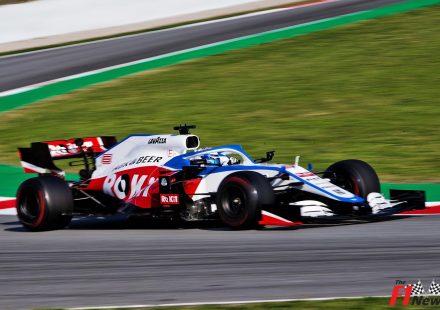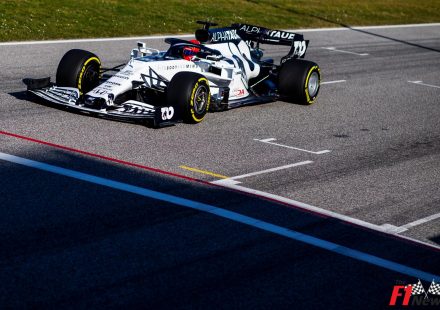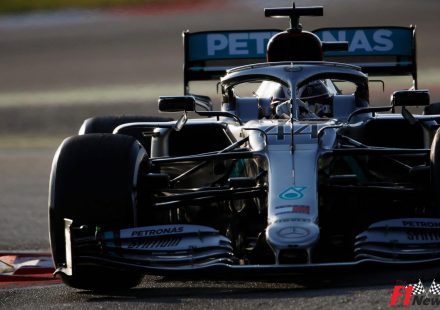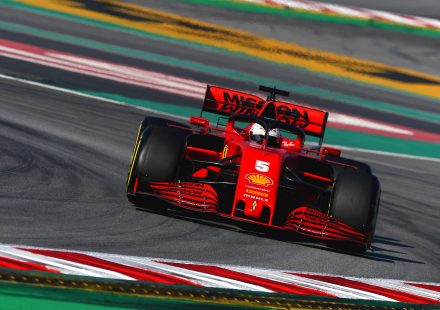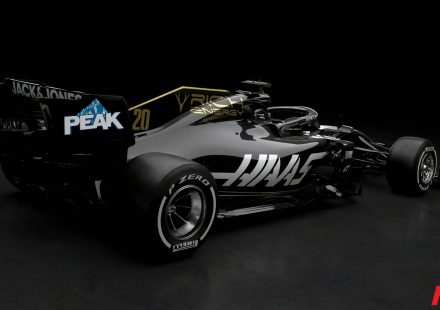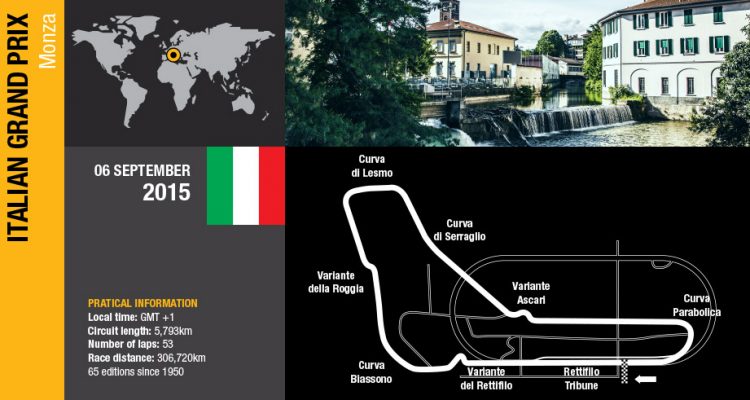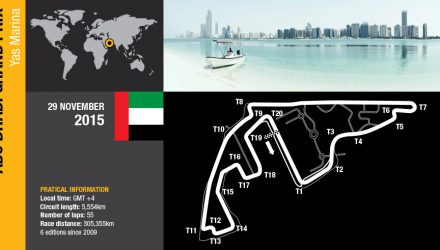RÉMI TAFFIN, DIRECTOR OF OPERATIONS
From a performance point of view, the Belgian Grand Prix was a positive one for us. Engine usage was much better than we have seen at the other high speed circuits, performance was improved and the power units worked well, particularly in conjunction with the low downforce configuration.
We hope to surf the Spa wave in Monza. It remains the hardest circuit of the year for power units, but we are confident that the latest engine specification will work well. This will be used by all drivers so at the very least we should be able to replicate the performance in Monza.
We can go to Monza with our heads high knowing we can compete shoulder to shoulder with the rest of the field.
RENAULT 2015 FAST FACTS
Monza is the most visited race track in the history of F1. It appeared on the calendar of the inaugural World Championship in 1950 and its layout is largely the same apart from the addition of the chicanes.
Monza is the shortest race of the season due to the short lap and high average speed. Last year’s race took just one hour 19 minutes at an average of 232kph. The 2003 race at this circuit broke the record for the shortest complete race in the history of F1.
With a possible top speed of 360kph, Monza is easily the quickest circuit on the calendar. The next quickest circuit would be Spa, but the quickest speed recorded at the Belgian Grand Prix was 344kph.
In the V8 era the top speed reached at Monza was a touch over 340kph, while it was over 370kph with a V10. That a lower capacity engine can match a gas guzzling V10 is a testament to advances in fuel efficiency and energy recovery and deployment.
The Renault RE30 became the first turbocharged car to win the Italian Grand Prix when Alain Prost raced to victory in 1981. Starting from third on the grid, Prost moved into an early lead and extended his advantage to finish 22secs ahead of the two Williams, driven by Alan Jones and Carlos Reutemann. The following year René Arnoux repeated the victory for Renault. Six Renault-powered wins followed in the normally-aspirated era; one for Mansell in 1991, two for Hill in 1993 and 1994 and one for Herbert in 1995. Sebastian Vettel raced to the win in 2011
FOCUS ON…ITALY 2011
The Autodromo di Monza has long been nicknamed the Cathedral of Speed, and with good reason. More than three quarters of the 5.793km track is taken at wide open throttle, with only three braking events punctuating the lap. For an engine supplier, it’s the ultimate test and, therefore, the ultimate Grand Prix to win.
Renault took four wins in the 1990s with Williams and Benetton, but victory eluded the Losange from the end of that decade throughout the noughties. Despite strong form ² throughout the V8 era, it took until 2011 for Renault to return to its winning ways in Monza. Director of operations Rémi Taffin recalls the relief at finally breaking the Monza draught.
‘We’d won the Italian Grand Prix in 1991, 1993, 1994 and 1995 but despite having some great cars and engines had never managed to take a victory since then. We’d come close in some years – 2005 for instance, when Fernando [Alonso] was only 2.5secs from Montoya, who had won that year. But the win had always eluded us.
‘From an engine supplier point of view, you have a love-hate relationship with Monza. You love it as it is the toughest challenge of the year and you see your engines reach speeds they do not reach elsewhere. But you are nervous the whole weekend. Winning this race therefore gives the greatest satisfaction.
‘In 2011 we went to Monza fairly confident and hopeful we’d break the deadlock. We’d won seven of the 11 races held so far that year and the Red Bull-Renault package had proved dominant. Reliability was outstanding and performance was good as we’d mastered the blown floor to give extra performance in the corners and the straights. Moreover, between Webber and Vettel and the year before we’d won at all of the ‘engine’ circuits – Spa, Canada, Abu Dhabi. There was a real hunger to win here, too.
‘Qualifying came on Saturday and Sebastian took the pole by nearly 0.5secs. It looked good for the win, but at Monza you never take anything for granted. Sebastian had a good start but Fernando was quicker and got ahead. For a couple of laps it looked as though Sebastian wouldn’t be able to find a way past, but there was an opportunity after the safety car period and he grabbed it with both hands. From that point on it was about maintaining the lead, nursing the car, making sure everything was safe. Even though Sebastian crossed the line almost nine seconds ahead of Button, until he did we didn’t think of the win.
‘The satisfaction when he did take the flag was immense. You know that your engine has made it and won in the toughest conditions. You feel both happy and proud, plus relieved! That win was made even more special by the fact it moved Sebastian into touching distance of his second championship.’
POWER UNIT DETAILS
ICE
Monza is the most power sensitive track of the season. More than 70% of the lap is spent at full throttle, more than any circuit of the season.
There are four long periods of open throttle, each with an average of 13secs each. The first is the pit straight, followed by the run through the Curva Grande, then from the Lesmos to the Variante Ascari and finally from Ascari to the Parabolica.
The longest time the Renault Energy F1 will be at full throttle is the pit straight, which lasts 16 secs.
The power units will reach the highest top speed of the season in Monza. We could see as much as 360kph with DRS open, even higher than last year, which was recorded as 354kph in Qualifying without tow. The Red Bull – Renault of Daniel Ricciardo achieved 362kph last year in the race when overtaking and getting a second tow from the car ahead.
Despite the ICE being flat out for approx three quarters of the lap, fuel consumption per kilometre is relatively low compared to slower tracks. This is due in part to the short length of the track and to maintaining a constant speed throughout, but also due to the high average speed with low downforce package that reduces the time spent to complete the distance.
The ICE will consistently run in the upper end of the rev range, but strong acceleration is more important than the top speed as the car will cover more ground quicker.
TURBOCHARGER
The long periods of wide open throttle generate a steady stream of exhaust gas. The energy available in the exhaust due to the high percentage of full throttle time means that the turbo will be at maximum speed for over 80% of the lap.
Tyre wear is a limiting factor to performance and strategy at this circuit. As such good low speed driveability is key to drive out of the chicanes. To achieve the desired boost target and ensure correct torque delivery from the PU. the turbo must be able to slow down and recover energy in the braking zone, plus avoid lag during the acceleration phase. This all needs to be done in less than six seconds, the time to go through the chicanes.
MGU-K
Despite the heavy braking for the three chicanes, the MGU-K is not significantly stressed in Monza. Each braking event is very short (under two seconds) and there are only three slow corners. In comparison to a corner-rich circuit such as Hungary, the MGU-K barely recovers the maximum energy allowed.
To compensate, the MGU-K recovers energy at partial throttle through overloading the ICE, although it will be difficult to harvest the max energy allowed by the regulations. The MGU-H will also feed the MGU-K down the straights.
MGU-H
The Parabolica and Lesmos are taken at partial throttle and provide the MGU-H with two opportunities to recharge the battery. The Parabolica is taken at a constant 180kph, delivering a steady stream of exhaust for the MGU-H.
The two Lesmos will also be taken at partial throttle. After Lesmo 1 the driver will step on the throttle and lift only slightly for the second Lesmo.
Otherwise the exhaust gases generated at full throttle will be used to harvest energy with the MGU-H at the end of the straights.

